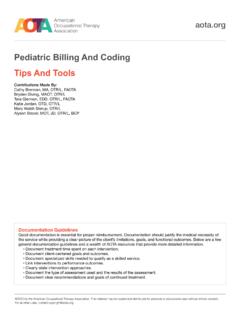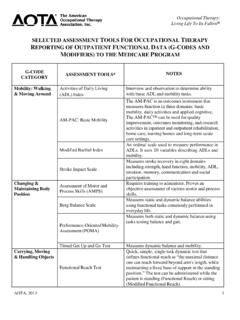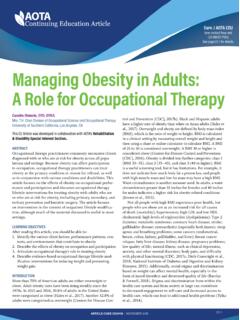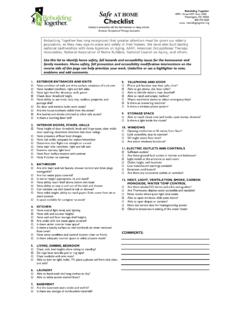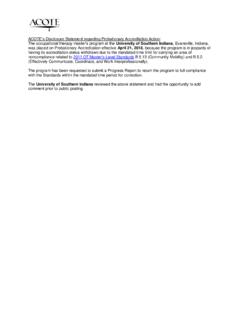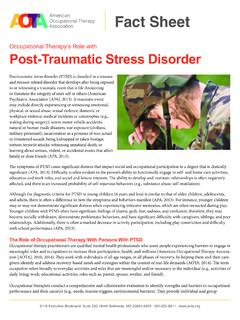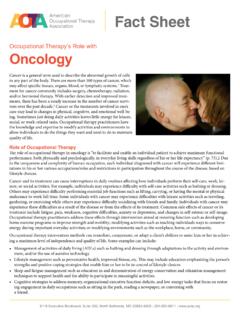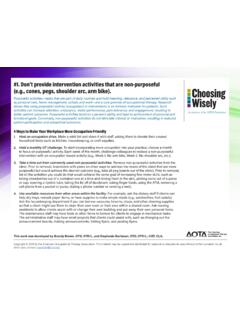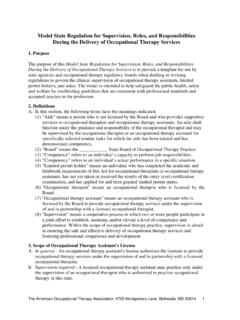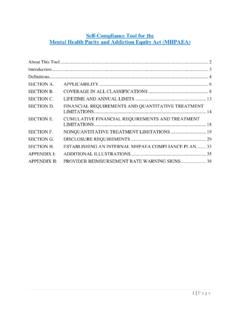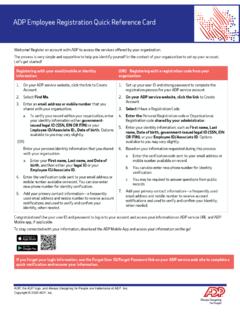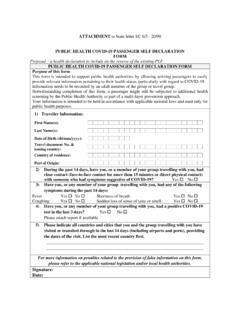Transcription of Self-Care and Mobility Section GG Items
1 2018 by the American Occupational Therapy Association. For questions about reuse of this document, visit The Items and descriptions are not copyrighted by AOTA but are published by the Centers for Medicare and Medicaid Services, 2012. For questions about reuse of Items and descriptions, visit 1 Client: _____ MRN: _____ Eval Date: _____ DC Date: _____Self-Care and Mobility Section GG ItemsSelf-Care CARE Items (Activities of Daily Living)The Self-Care CARE Items do not replace standardized assessments that occupational therapy may use for evaluation. These Items are being implemented across all post-acute care (PAC) settings by Medicare (CMS). For more information and scoring information, see the Medicare Assessments linked on the last page. Many assessments that provide information about ADL performance also provide information about cognition, vision, and other concerns.
2 After completing the Occupational Profile, complete and document various assessments to gather essential data for your initial evaluation. Use the form below to score and document Self-Care Items . This tool can be implemented in any adult care setting. See page 2 for scoring information. See page 3 for transfer and Mobility = Independent; 5 = Setup or Cleanup Assistance; 4 = Supervision or Touching Assistance; 3 = Partial/Moderate Assistance; 2 = Substantial/Maximal Assistance; 1 = Dependent; 07 = Refused; 09 = Not Applicable; 10 = Not attempted due to environment limitation; 88 = Not attempted due to medical Items (Assessment Item GG 0130**)AdmissionGoalDischargeItemDefinit ionAEatingThe ability to use suitable utensils to bring food and/or liquid to the mouth and swallow food and/or liquid once the meal is placed before the HygieneThe ability to use suitable Items to clean teeth.
3 Dentures (if applicable): The ability to insert and remove dentures into and from the mouth, and manage denture soaking and rinsing with use of HygieneThe ability to maintain perineal hygiene, adjust clothes before and after voiding or having a bowel movement. If managing an ostomy, include wiping the opening but not managing Upper Body**Wash Upper Body is only reported in LTCH. The ability to wash, rinse, and dry the face, hands, chest, and arms while sitting in a chair or bed. EShower/ Bathe self *Shower/Bathe self is only reported in IRF, SNF, and HH. The ability to bathe self , including washing, rinsing, and drying self (excludes washing of back and hair). Does not include transferring in/out of Body Dressing*The ability to dress and undress above the waist; including fasteners, if Body Dressing*The ability to dress and undress below the waist, including fasteners; does not include on/Taking off Footwear*The ability to put on and take off socks and shoes or other footwear that is appropriate for safe Mobility ; including fasteners, if 1 for each response of 07, 09, or , SNF, or HH TotalFor IRF, SNF, or HH, add lines A, B, C, E, F, G, H (A score of 7 42 is possible.)
4 LTCH TotalFor LTCH, add lines A, B, C, D (A score of 4 28 is possible.)*Indicates the item is not yet reported to CMS in Long Term Care Hospitals (LTCH). **Indicates the item is only reported to CMS in LTCH. **These Items correspond with item GG 0130 in the 4 Medicare assessments, including the Skilled Nursing Facility Minimum Data Set (MDS), Inpatient Rehabilitation Facility Patient Assessment Instrument (IRF PAI), Long Term Care Hospital Continuity Assessment Record Evaluation Tool (LTCH CARE), and the Home Health Outcome and Assessment Information Set (OASIS).HH = home health; IRF = inpatient rehabilitation facility; SNF = skilled nursing facility; LTCH = Long Term Care the facility will report the client s usual performance over the first 3 days of admission for each item to 2018 by the American Occupational Therapy Association.
5 For questions about reuse of this document, visit The Items and descriptions are not copyrighted by AOTA but are published by the Centers for Medicare and Medicaid Services, 2012. For questions about reuse of Items and descriptions, visit 2 Scoring AlgorithmSee the chart below to help score each item. Adaptive equipment and assistive devices may be used for any score. For more information, see 6: Independent Person completes the activity by himself/herself with no assistance from a helper. 5: Setup or cleanup assistance Helper SETS UP or CLEANS UP; person completes activity. Helper assists only prior to or following the activity. (The helper can walk away and leave the person to complete the task.) 4: Supervision or touching assistance Helper provides VERBAL CUES or TOUCHING/STEADYING and/or CONTACT GUARD ASSISTANCE as person completes activity.
6 Assistance may be provided throughout the activity or intermittently. 3: Partial/moderate assistance Helper does LESS THAN HALF the effort. Helper lifts, holds, or supports trunk or limbs but provides less than half of the effort. 2: Substantial/maximal assistance Helper does MORE THAN HALF the effort. Helper lifts or holds trunk or limbs and provides more than half the effort. 1: Dependent Helper does ALL of the effort. Person does none of the effort to complete the activity. Or, the assistance of 2 or more helpers is required for the person to complete the : Refused. 09: Not applicable. 10: Not attempted due to environmental limitations. 88: Not attempted due to medical condition or safety the client complete the task with no assistance?(with or without adaptive equipment)Can the person be left alone to do the task after setup?
7 Does the helper provide only supervision (verbal cues) or light touch?Does the helper provide LESS THAN HALF of the effortto complete the task?Does the helper provide MORE THAN HALF, but less than 100%, of the effort to complete the task?Does the helper need to do 100% of the task?Are 2 or more helpers needed at any time ?IndependentSetup or Cleanup AssistanceSupervision or Touching AssistancePartial/ Moderate AssistanceSubstantial/ Maximal 2018 by the American Occupational Therapy Association. For questions about reuse of this document, visit The Items and descriptions are not copyrighted by AOTA but are published by the Centers for Medicare and Medicaid Services, 2012. For questions about reuse of Items and descriptions, visit 3 Mobility CARE Items (Assessment** Item GG 0170)6 = Independent; 5 = Setup or Cleanup Assistance; 4 = Supervision or Touching Assistance; 3 = Partial/Moderate Assistance; 2 = Substantial/Maximal Assistance; 1 = Dependent; 07 = Refused; 09 = Not Applicable; 10 = Not attempted due to environment limitation.
8 88 = Not attempted due to medical left and rightThe ability to roll from lying on back to left and right side, and return to lying on back on the to lyingThe ability to move from sitting on side of bed to lying flat on the to sitting on side of bedThe ability to move from lying on the back to sitting on the side of the bed with feet flat on the floor, and with no back to standThe ability to come to a standing position from sitting in a chair, wheelchair, or on the side of the transferThe ability to transfer to and from a bed to a chair (or wheelchair).FToilet transferThe ability to get on and off a toilet or transferThe ability to transfer in and out of a car or van on the passenger side. Does not include the ability to open/close door or fasten seat 10 feetOnce standing, the ability to walk at least 10 feet in a room, corridor, or similar space.
9 If admission performance is 07, 09, 10, or 88, Skip to M, 1 Step (curb). JWalk 50 feet with 2 turnsOnce standing, the ability to walk at least 50 feet and make 2 150 feetOnce standing, the ability to walk at least 150 feet in a corridor or similar 10 feet on uneven surfacesThe ability to walk 10 feet on uneven or sloping surfaces (indoor or outdoor), such as turf or Step (curb)The ability to go up and down a curb and/or up and down 1 step. If admission performance is coded 07, 09, 10, or 88, skip to P, Picking up object. N4 StepsThe ability to go up and down 4 steps with or without a rail. If admission performance is 07, 09, 10, or 88, Skip to P, Picking up object. O12 StepsThe ability to go up and down 12 steps with or without up objectThe ability to bend/stoop from standing position to pick up small object, such as spoon, from R and S only if the client uses a wheelchair.
10 Check: manual wheelchair motorized wheelchairRWheel 50 feet with 2 turnsOnce seated in wheelchair/scooter, can wheel at least 50 feet and make 2 150 feetOnce seated in wheelchair/scooter, can wheel at least 150 feet in corridor or similar space.**These Items correspond with item GG 0170 in the 4 Medicare assessments, including the Skilled Nursing Facility Minimum Data Set (MDS), Inpatient Rehabilitation Facility Patient Assessment Instrument (IRF PAI), Long Term Care Hospital Continuity Assessment Record Evaluation Tool (LTCH CARE), and the Home Health Outcome and Assessment Information Set (OASIS). 2018 by the American Occupational Therapy Association. For questions about reuse of this document, visit The Items and descriptions are not copyrighted by AOTA but are published by the Centers for Medicare and Medicaid Services, 2012.
